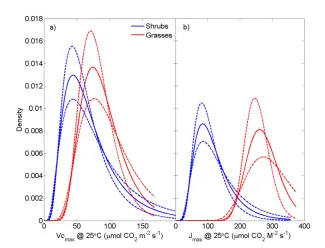We have compiled a comprehensive plant trait dataset for Arctic plants from existing plant trait databases and NGEE Arctic measurements to investigate how key traits used in Earth System Models differ within and between plant groups. The databases used included TRY (maintained by Max-Planck-Institute, Jena), FRED (maintained by Oak Ridge National Laboratory), and LTER Arctic (maintained by Marine Biological Laboratory), and they key traits analyzed were photosynthetic capacity (parameters Vc_max and Jmax @ 25C), root-to-shoot ratios, fine root-to-leaf biomass ratios and root nitrogen content. Our results show that Arctic shrubs differ significantly from grasses and sedges in the photosynthetic parameters (see figure), but the distribution of root-to-shoot ratios, fine root-to-leaf biomass ratios and root nitrogen content, were similar in all groups. Our analysis also revealed that there is limited data for Arctic species and NGEE Arctic measurement efforts on these traits are essential to establish adequate description of trait distributions for the Arctic in Earth System Models (ESMs). In order to incorporate the complete information of these trait distributions into ESMs, we have developed an integral projection model (IPM) to account for the spatial heterogeneity and individual-level variations in to ESMs with FATES. Our preliminary tests of IPM showed that the IPM is able to capture individual and environmental variability computational efficiently through a theoretical exploration. Our next step is to test the model’s capability to capture fine-scale statistics at NGEE Arctic sites.
For more information, please contact:
Sanna Sevanto
sanna@lanl.govChonggang Xu
cxu@lanl.gov

